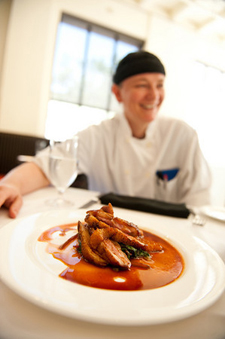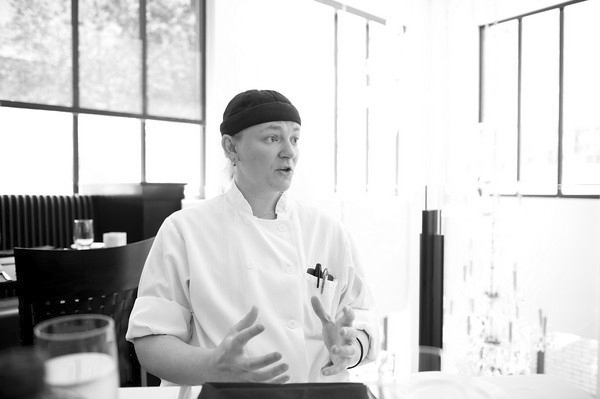
Editor’s Note: Porter & Frye is now closed.
For all its WASPy branding and polish, Porter & Frye is a surprisingly vulnerable kind of place. It opened in 2008 with a seismic wave of publicity, employing locally prominent chefs including Steven Brown, Erik Anderson (now at Sea Change), and Doug Flicker (running Piccolo). But since then, the hotel-based restaurant has wrestled with rapid talent turnover and a not-unrelated identity crisis over the span of its brief lifespan.
Currently helming the restaurant with a minimum of fuss or PR attention is Sarah Master. Master did strong, consistent cooking at Barbette, incorporating touches of her New Orleans training while upholding the turbulence-proof consistency that makes Barbette one of Uptown’s most dependable bets.
According to Dara Moskowitz Grumdahl, the executive chef position at Porter & Frye once reportedly scared off Erik Anderson, since it was all administration and no actual cooking. One of the first things we asked Master was how much time she actually spends in the kitchen.

“I made it very clear when I was offered the job here that I’m very much into the creative aspect of it — I love being on the line, I love being in the kitchen… and I don’t like sitting at meetings, and I don’t like sitting at my computer,” she says. “They’ve been very good when there is a meeting to say: ‘OK, let’s get Sarah’s stuff done first so we can get her back in the kitchen.'”

The job of executive chef at Porter & Frye still involves a fair bit of organizational oversight; banquet catering and room service from the 136-room Hotel Ivy represent much of its business, and would depress (and probably have depressed) chefs looking for total creative freedom. But within those constraints, Master has brought new life to the upscale American, business-friendly menu, and she is creating food that deserves a second look from the locals.
HEAVY TABLE: How has Porter & Frye evolved since its founding? Where is it now?
SARAH MASTER: [The concept] has definitely shifted — it was very high-end, cutting-edge Steven Brown food when it first opened. He had a heck of a staff.
They wanted to shift it to be a little more accessible, I guess, when Joan [Ida] was here — and more so with me being here. I really enjoy the bistro kind of concept I had at Barbette, and they want to do a lot of the same things here that I did there — local, sustainable, organic.
Steven Brown was using quite a few local purveyors, and then it kind of shifted [under Joan Ida] to not being as local. But now, yeah… I’ve made a lot of phone calls. Called in a lot of favors.
HT: Who are some of the purveyors you’re using now?
MASTER: I’m using a lot of the same farms I used at Barbette — Fischer, Dragsmith, Footjoy. We use Hidden Stream.
HT: When you talk about shifting to be more “accessible,” that’s code for something — what does “accessible” mean in this context? Or inaccessible?
MASTER: Something that’s not quite as accessible is something that takes interaction from the diners — a lot of the [deconstructed and / or molecular gastronomy] Alinea style food. It’s interesting for a little while, but I think diners in Minneapolis are more interested in eating locally.
HT: This place is obviously kind of a beast to run — what are you bringing to the table here?
MASTER: Definitely bringing in that local, sustainable knowledge I got at Barbette has been a huge help. I do think that’s what local diners want. Also, I’m an insanely organized, OCD person. That’s something this place was lacking before, was proper inventory control, just kind of the organizational aspects. If you can do that well, the food is also easy.
You’re not wandering around wondering where the cheese is… ‘Oh my God, do we have clams? Where are the clams?’ It’s all about being organized and teaching the cooks to be organized. It was a lot of line cooks with a lot of ideas, but there was no one there to say, ‘Here’s what we’re going to do, here’s what the system is going to be.’
[Food arrives]

HT: Oh, man. Tell me a little bit about what we’re eating here.
MASTER: This one is seared duck breast from Wild Acres — it’s got local, organic baby Swiss chard that was actually grown in one of my cooks’ gardens. It’s got orange segments and an orange / cane sugar demi[glace].
HT: What’s the inspiration?
MASTER: Duck a l’Orange. And I’ve always got a bit of Southern deep down inside me, and that’s where the cane syrup comes from. I like the nuttiness of cane syrup, as opposed to anything that could replace it.
HT: There’s a great crispiness to the skin — and it’s tender, properly cooked duck, not fatty, not overseasoned — not too sweet — and the chard is great. How are the orange segments done?
MASTER: We just give them a quick flash in the pan to develop the sugars in there and sweeten them up.
HT: You’ve said before that you were born up on the Iron Range, but that’s not where you learned to cook. What’s the story with your New Orleans connection?
MASTER: I spent a lot of time at Bayona in New Orleans [headed by Beard winner Susan Spicer] — I learned all of my really barebones structure from working there. So I always think about things that I did there. Sometimes it’s a little difficult to execute that up here — people’s palates are a little different than up here, and people go to New Orleans to eat, so they’re willing to try anything. They’re not as adventurous up here. But people aren’t boycotting foie gras because they know the stuff we’re getting locally is humanely raised.

HT: So, there’s a culinary twist to what’s going on here — a little more seasonal, a touch of the South here and there. Otherwise, how has the menu shifted, at all?
MASTER: It’s really not the same restaurant it was. The prices used to be quite high, and now they’re not — they highest price thing we have on the menu right now is a bison tenderloin, and that’s $29. We’re trying to keep the prices quite reasonable but still serve the best product we possibly can.
HT: Any new team members you want to spotlight?
MASTER: I brought in a former cook of mine from Barbette to be my sous chef — her name is Liz Olson. She has been fantastic — she worked at Chowgirls [Killer Catering] for quite a while. She had left Barbette to go to Chowgirls and I called her up [after I got this job] and said, ‘Please come help me!’
She’s been really great, she’s got the catering experience — that helps with a lot of the banquet stuff. Other than that, I brought in a lot of people I worked with… the staff, as there always is when a new chef comes in, there’s a revolving door for a little while. We’re definitely calming down and becoming more like a solid team.

HT: OK, tell us a little bit about this trout dish.
MASTER: Right now we are doing a crab- and pecan-stuffed Star Prairie trout. It’s got panzanella and some horseradish tartar sauce. I can’t say I’m a huge fan of tartar sauce, but people love it. Sometimes you’ve got to give people what they want to get them in the door.
HT: Really balanced. This will sound a bit crazy, but I had crab-stuffed trout last night at Alma, too. I dig them both. This is richer and more involved, but still well balanced. Alma was a little more austere, but also great. Love the Star Prairie trout.
MASTER: Their natural spring water makes a big difference — the color and flavor is really unmatched.
HT: OK, this is supposed to be “Two Tastes With…” but you’ve put out a bison grinder for us, too. Tell us about it.

MASTER: We had a lot of bison scraps after cleaning the tenderloins, and I’m very much into ‘tail to snout,’ so we had to figure out how to use the tenderloin scraps… My husband works at the Red Stag and we’ve had the meatloaf grinder there a number of times — that was an idea that I really liked that I wanted to bring in here. Everybody in the Midwest loves meatloaf sandwiches.
HT: It’s almost like a tartare on a bun — it’s got this onion-studded lightness to it.
MASTER: The bread is from New French [Bakery], and we’re using an onion chow chow — onions, jalapenos, whole grain mustard, a bit of turmeric, and garlic.
HT: Any closing thoughts on who you’re hoping to draw in to the restaurant as you move forward?
MASTER: I don’t think there’s a lot of people who live in the Twin Cities who know us — we haven’t done a lot of advertising, which has been a frustration. I want to get this place out there, I want this place packed every night. People in the Twin Cities don’t really know we’ve gone in a different direction in terms of price and local produce.

I had the trout at Porter & Frye just the other night and was really surprised at how good it was – just rich enough, just fishy enough, not too much stuffing. I loved it.
thanks for this, good interview James… I’m glad to know P&F has evolved, I went quite a while ago and wasn’t super happy with it, but this interview makes me consider going back…
Really nice interview. Nice to hear about an organized, down-to-earth chef bringing P&F under control. Loved her food at Barbette – and will have to make it to P&F.
Congratulations Sarah, and continued success!~( organization rules )